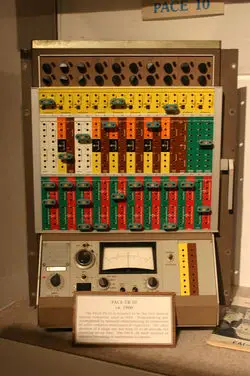From WikiChip
Difference between revisions of "electronic associates/pace tr-10"
m |
(Adjusted link to item in computer museum) |
||
| (One intermediate revision by the same user not shown) | |||
| Line 33: | Line 33: | ||
== Museum displays == | == Museum displays == | ||
* [http://www.analogmuseum.org/english/collection/eai/tr10/ TR-10], Analog Museum | * [http://www.analogmuseum.org/english/collection/eai/tr10/ TR-10], Analog Museum | ||
| + | * [http://museo.ovh/index.php/nav=Catalogo.20/Language=ITA/Mode=Display/User=/Letter=E/Livello=Macchina/Marca=571/Item=3784/Pagina=Fotografie TR-10], Museo del Computer | ||
== Documents == | == Documents == | ||
Latest revision as of 08:06, 24 April 2023
| PACE TR-10 | |

| |
| PACE TR-10 at the National Cryptologic Museum. | |
| Developer | Electronic Associates |
| Manufacturer | Electronic Associates |
| Product family | PACE Series |
| Type | analog computer |
| Release date | 1959[1] |
| Introductory price | $4,000-11,000[1] |
| | |
| Size | 16" wide, 24" height, 15" depth |
| Weight | 95LB |
| | |
| Operating Range | +/-10V |
| Components |
|
The PACE TR-10 was a fully transistorized general-purpose analog computer developed by Electronic Associates in 1959. This was EAI's first and smallest transistorized analog computer. The TR-10 was also the smallest in the PACE family, capable of solving tenth-order differential equations. The TR-10 became well known for its flexibility and robustness.
Details[edit]
| This section is empty; you can help add the missing info by editing this page. |
Slave network[edit]
| This section is empty; you can help add the missing info by editing this page. |